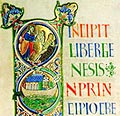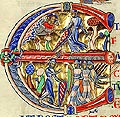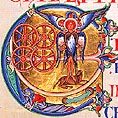![]() Manuscript Illumination in England
Manuscript Illumination in England
 When
the Normans invaded England they took over a country larger and much more
wealthy than their own and, as if to emphasize their dominance, began to construct
huge architectural works in stone. By the early years of the 12th century
much of the building work, particularly that of the great churches and monasteries,
was nearing completion and attention could now be turned to embellishment.
This took the form of increased architectural decoration, wall-paintings and
book production.
When
the Normans invaded England they took over a country larger and much more
wealthy than their own and, as if to emphasize their dominance, began to construct
huge architectural works in stone. By the early years of the 12th century
much of the building work, particularly that of the great churches and monasteries,
was nearing completion and attention could now be turned to embellishment.
This took the form of increased architectural decoration, wall-paintings and
book production.
 The
Benedictine foundations were in the forefront of book production and illumination.
Because of the balance of the Rule of St Benedict between prayer, work and
study they were in a better position than some of the other orders to devote
time to the pursuit of learning. The monasteries of St Albans, Canterbury
and Winchester and others produced Psalters, commentaries on the scriptures
and, most strikingly, a series of great Bibles, lavishly illustrated with
initials and whole-page narrative scenes. The Winchester Bible is the most
ambitious of these and was written, probably under the patronage of Henry
of Blois (Bishop of Winchester 1129-1171), between about 1160 and 1180.
The
Benedictine foundations were in the forefront of book production and illumination.
Because of the balance of the Rule of St Benedict between prayer, work and
study they were in a better position than some of the other orders to devote
time to the pursuit of learning. The monasteries of St Albans, Canterbury
and Winchester and others produced Psalters, commentaries on the scriptures
and, most strikingly, a series of great Bibles, lavishly illustrated with
initials and whole-page narrative scenes. The Winchester Bible is the most
ambitious of these and was written, probably under the patronage of Henry
of Blois (Bishop of Winchester 1129-1171), between about 1160 and 1180.

 It
is a complete Bible, Old Testament, Apocrypha and New Testament, written,
by one scribe (with minor interventions by a second), on 468 leaves of calf-skin
parchment and punctuated with 54 complete or partially complete initials by
at least six different artists working over a period of about 20 years. The
text is complete but the fact that the initials become less and less complete
towards the end of the manuscript perhaps indicates that the money provided
by the Bible's sponsor was not quite enough to complete this sumptuous work.
It remains today in the Library at Winchester Cathedral, the building for
which it was created over 800 years ago.
It
is a complete Bible, Old Testament, Apocrypha and New Testament, written,
by one scribe (with minor interventions by a second), on 468 leaves of calf-skin
parchment and punctuated with 54 complete or partially complete initials by
at least six different artists working over a period of about 20 years. The
text is complete but the fact that the initials become less and less complete
towards the end of the manuscript perhaps indicates that the money provided
by the Bible's sponsor was not quite enough to complete this sumptuous work.
It remains today in the Library at Winchester Cathedral, the building for
which it was created over 800 years ago.
John Hardacre
Winchester Cathedral